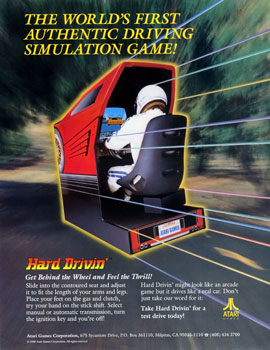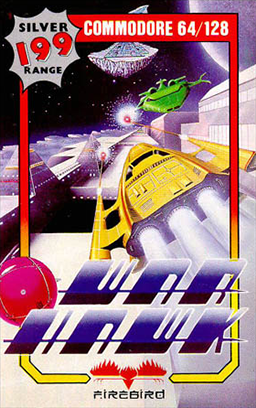
Silent Service is a submarine simulator video game designed by Sid Meier and published by MicroProse for various 8-bit home computers in 1985 and for 16-bit systems like the Amiga in 1987. A Nintendo Entertainment System version developed by Rare was published in 1989 by Konami in Europe and by Konami's Ultra Games subsidiary in North America. Silent Service II was released in 1990. Tommo purchased the rights to this game and published it online through its Retroism brand in 2015.

Star Wars is a first-person rail shooter designed by Mike Hally and released as an arcade video game in 1983 by Atari, Inc. It uses 3D color vector graphics to simulate the assault on the Death Star from the 1977 film Star Wars. There are three connected gameplay sequences: combat against TIE fighters in space, flying across the surface of the Death Star, and the final trench run. The sequence repeats with added complications and the Death Star regenerating for each. The player's X-Wing fighter has a shield which only protects against damage a certain number of times, then the next hit ends the game. Speech synthesis emulates actors from the film.

Exile is a single-player action-adventure video game originally published for the BBC Micro and Acorn Electron in 1988 by Superior Software and later ported to the Commodore 64, Amiga, CD32 and Atari ST, all published by Audiogenic. The game was designed and programmed by Peter Irvin and Jeremy Smith. It is often cited as one of the earliest examples of a Metroidvania game and featured "realistic gravity, inertia and object mass years before players understood the concept of a physics engine... an astounding level of AI, stealth-based gameplay, a logical ecosystem governing the world's creatures and a teleportation mechanic that feels startlingly like a predecessor to Portal".

Lords of Chaos is a turn-based tactics tactical role-playing game published by Blade Software in 1990. It is the sequel to Chaos and an ancestor of the popular X-COM series of games, also written by Julian Gollop. In Lords of Chaos each player controls a wizard who can cast various magic spells. The spells have various effects, for example summoning other creatures, or damaging opposing creatures and wizards. The game can be played against a computer-controlled opponent or by up to four human players.

Last Ninja is a series of video games published by System 3. The first game in the series titled The Last Ninja, was released in 1987 for the Commodore 64 and was one of the most successful games for the system. In 1988, System 3 released Last Ninja 2, and in 1991 the third game in the series, Last Ninja 3. In 1990, Last Ninja Remix was released for 8-bit systems. This was Last Ninja 2 with new music, a new introductory sequence, slightly changed graphics and fixed bugs. Confusingly, the 16-bit versions of the original The Last Ninja game were also released in 1990 as Ninja Remix.

Raid Over Moscow is a video game by Access Software published in Europe by U.S. Gold for the Commodore 64 in 1984 and other microcomputers in 1985-1986.

Stellar 7 is a first-person tank simulation video game based on the 1980s arcade game Battlezone in which the player assumes the role of a futuristic tank pilot. The game was created by Damon Slye for the Apple II and Commodore 64 in 1983, then remade in the early 1990s for MS-DOS, Amiga, and Classic Mac OS. There are three sequels: Arcticfox (1986), Nova 9: The Return of Gir Draxon (1991), and Stellar 7: Draxon's Revenge (1993).

Gladiator, known in Japan as Ougon no Shiro, is an arcade video game developed by Allumer and published in 1986 by Taito. It was followed by a sequel titled Blandia. Home ports of Gladiator were released for the ZX Spectrum, Amstrad CPC and Commodore 64 as Great Gurianos; the Spectrum version was intentionally made unwinnable.

Cybernoid: The Fighting Machine is a shoot 'em up developed and published in 1988 by Hewson Consultants for the ZX Spectrum. It was ported to the Amstrad CPC, Atari ST, Commodore 64, Amiga, and Nintendo Entertainment System. It was programmed by Raffaele Cecco. The ZX Spectrum, Amstrad, and Atari ST versions have a main theme by Dave Rogers, while the Commodore C64 version has a different theme by Jeroen Tel.

Alien 3 is a run and gun game based on the 1992 film of the same name. It was released for the Genesis and Amiga in 1992, then for the Commodore 64, Game Boy, Game Gear, Nintendo Entertainment System, Super Nintendo Entertainment System, and Master System.

Hard Drivin' is a sim racing arcade video game developed by Atari Games in 1989. Players test drive a sports car on courses that emphasize stunts and speed. It features one of the first 3D polygon driving environments via a simulator cabinet with a haptic vibrating steering wheel and a custom rendering architecture.

Warhawk is a vertically scrolling shooter published in 1986 by Firebird software. It was released for the Commodore 64, Atari 8-bit computers, Amstrad CPC, and Atari ST.

Beach Head II: The Dictator Strikes Back is 1985 video game for the Commodore 64, a sequel to Beach Head, developed and published by Access Software. It was designed by Bruce Carver and his brother, Roger, and was released for the Amstrad CPC, Apple II, Atari 8-bit computers, Commodore 64, and ZX Spectrum.

Spitfire Ace is a combat flight simulator video game created and published by MicroProse in 1982 shortly after it was founded. It was one of the first video games designed and programmed by Sid Meier, originally developed for Atari 8-bit computers and ported to the Commodore 64 and IBM PC compatibles in 1984. The game followed on the heel's of Meier's Hellcat Ace, also from 1982 and for the Atari 8-bit computers.

Panther is a Commodore 64 game designed and implemented by Peter Adams and published by Mastertronic in 1986. A version for Atari 8-bit computers followed in 1987, then a ZX Spectrum port in 1989. The player pilots a strange-looking aircraft, fighting off hordes of invading flying saucers and rescuing people by landing the craft and waiting for them to board. The game uses a diagonally scrolling isometric view, much like Zaxxon and Blue Max, using shadows to show the height of flying objects. Adams previously worked on ports of both of those games.

Survivors is a puzzle video game published by Atlantis Software in 1986 for the ZX Spectrum. It was ported to the MSX, Atari 8-bit computers, Commodore 64, Commodore 16, Acorn Electron, and BBC Micro and the Amstrad CPC (1988). It is based on the "rocks and diamonds" mechanics of Boulder Dash.

Pink Panther is a 1988 video game based on the character of the same name. It was developed by German company Magic Bytes and published by Gremlin Graphics. It was released in Europe for Amiga, Amstrad CPC, Atari ST, Commodore 64, and ZX Spectrum. Pink Panther was criticized for its control and difficulty, although the Amiga and Atari ST versions received praise for their graphics.

Pastfinder is a vertically scrolling shooter designed by David Lubar and published by in 1984 by Activision for the Atari 8-bit computers, Commodore 64, and MSX.

Stealth is a pseudo-3D rail shooter designed by Tracy Lagrone and Richard Sansom. The game was published in 1984 by Broderbund for the Atari 8-bit computers and Commodore 64.

Red Max is an action game developed by David Darling and published by Codemasters in 1987. It was released for the Atari 8-bit computers and Commodore 64. This game closely resembles Darling's earlier work, The Last V8. The graphics were created by James Wilson, with music composed by David Whittaker.





















